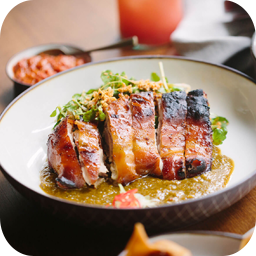Indonesian Babi Guling is a traditional roast pig dish from Bali, Indonesia. It is one of the most iconic and celebrated Balinese dishes, often served at ceremonial and festive occasions. The dish involves roasting a whole pig stuffed with a rich blend of spices, resulting in crispy skin, tender meat, and a medley of aromatic flavors.
Key Features of Babi Guling:
- Preparation:
- Whole Pig: A whole young pig is used for the dish, cleaned, and prepared for stuffing and roasting.
- Spice Mixture (Bumbu): The pig is stuffed with a traditional Balinese spice mixture called Bumbu Bali, which typically includes:
- Turmeric
- Garlic
- Shallots
- Lemongrass
- Ginger
- Galangal
- Chili
- Coriander
- Candlenuts
- Shrimp paste
- Filling: Additional ingredients like cassava leaves are often used to enhance the flavor.
- Cooking Method:
- The stuffed pig is skewered on a spit and slowly roasted over an open flame. The slow roasting ensures the skin becomes crispy and golden, while the meat remains juicy and flavorful.
- Serving Style:
- Babi Guling is typically served with rice, lawar (a traditional Balinese salad made of vegetables, coconut, and sometimes minced meat), crispy skin, and a spicy sambal.
- Cultural and Ceremonial Significance:
- Babi Guling is deeply rooted in Balinese culture and is often prepared for temple offerings, weddings, and community gatherings.
- It represents communal harmony and is usually a centerpiece in traditional feasts.
- Flavor Profile:
- The dish is savory and aromatic with hints of spice, sweetness, and smokiness from the roasting process.
- Regional Specialty:
- While Babi Guling is associated specifically with Bali, similar roasted pig dishes can be found in other parts of Indonesia, albeit with different spice blends and cooking techniques.
Fun Fact:
Traditionally, Babi Guling was reserved for special occasions, but today, it’s also enjoyed as a popular dish in Balinese restaurants and warungs (small eateries).

